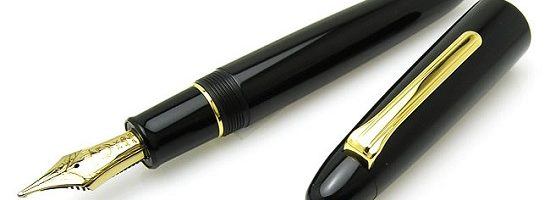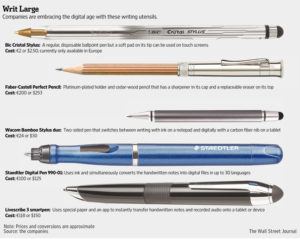Is the Pen So Mighty After All?

Will the notetaking industry soon tear at the seam?
Paperless statements, paperless billing, and paperless tax-returns. While the world is becoming more and more paperless every day, one area where paper and pen is still preferable is note taking. Every year 21 million college in students in America buy well over 100 million notebooks and pens to take class notes. Legal pads and notebooks flood every office allowing meeting constituents to jot down important points and action items. It’s not that paper and pens are ideal, convenient, or organized; it’s that for centuries they have been the only tools that get the job done.
Pen and paper have been ideal tools for note taking for two reasons. First, notes are what computer scientists calls “unstructured data.” Unlike a word document, excel spreadsheet, or PowerPoint presentation; there is no common format that notes share. Some may require bullet points, some paragraphs of text, and some quick diagrams or images. Paper and pen is great for this because there is no structure in a blank piece of paper – you can write wherever and draw whatever you want. Second, handwriting is incredibly quick and intuitive. While it is technically possible to type a math equation into word, it’s slow, clunky and unintuitive. With a paper and pen it’s as simple as copying whatever symbol you see on a chalkboard.
Even though paper and pens do a great job at taking unstructured notes, they are awful at organizing them. Papers get lost, out of place, and hard to find. Computers seem to be a logical improvement to this issue because they can work with unstructured data just fine and are fantastic at organization. Historically, however, it’s been hard for computers to significantly improve the note taking experience because they have been awful to write on (think of grocery store check-outs where legibly signing your name on a digital pad is all but impossible). This is beginning to change. New changes in digital writing technology and friendly application program interfaces (APIs) are bringing accurate digital handwriting to the masses. Digital pens now have highly sensitive pressure sensors, mimicking the behavior of their traditional counterparts almost perfectly. Thinner screens and sensors increase precision, ensuring that where you think you are writing is where the digital ink shows up on the screen. Faster processing allows for digital ink to appear on the screen as quickly as a digital pen transverses it. In short, with modern digital pens and displays, computers have bridged the handwriting gap.
|
Historical |
Current | |||
| Organization | Effectiveness* | Organization |
Effectiveness |
|
|
Pencil and Paper |
Awful | Good | Awful |
Good |
| Computers | Great | Awful | Great |
Great |
| *Effectiveness refers to ease of use, quickness, precision. | ||||
The arrival of accurate and accessible digital handwriting is poised to rock the 11-billion-dollar pen and pencil industry. Computing devices smaller than a traditional notebook are taking center stage with college students. Two of the more popular products in this category are Apple’s iPad Pro and the Microsoft’s Surface Pro 4. Both have highly accurate digital handwriting technology built into them2,3. Other hardware manufactures are likely only one short generation behind. They are sure to follow suit and the technology will only proliferate. Traditional writing and pen companies are trying to embrace the digital age but so far their efforts have largely only resulted in adding stylus ends to their otherwise unchanged writing products1 (essentially combining two outdated technologies into one device). These innovations will not save them from the digital handwriting revolution. The industry needs to start making rapid and significant advances in innovating new, digital-age products.

It will be interesting to see how digital notebooks, pens, books, and papers continue to change the academic and professional landscape. So much of the world around us revolves around the traditional paper and pen industry. As with any innovation, new opportunities are sure to arise from the technology and there are likely exciting new innovations to be made and profitable new companies that will be formed. The question that remains is whether the major players in the current paper and pen space will pivot before they run out of ink.
(682 Non-handwritten Words)
References:



Interesting post! Do you think that the entrance of Apple into the digital pencil world will increase overall adoption rates? Microsoft introduced the Surface Pen in 2012 but the technology has been plagued with issues, which limited its popularity. Given Apple’s somewhat cult status, will customers be more inclined to try the new technology? The technology still seems somewhat clunky so I’m hesitant to believe that the traditional pen/paper method will become obsolete anytime soon.
I’d also be curious to see if a larger number of entrants will actually give the “smart pen” traction. This seems like an area where the cost difference between existing and new technology is so great that it will take a while for new technology to catch on.
The difference between losing a $60 pen and $.6 pen is pretty high, so if you’re able to find a way to work the existing tech into a new framework you may be able to give consumers the benefit of smart notes without a major infrastructure investment. Moleskine and Evernote have partnered to create a smart notebook that can translate ink notes into a digital form, and I’d be curious to see if this is able to gain market share more quickly.
https://store.moleskine.com/usa/en-us/Moleskine-/Evernote/C26?gclid=CjwKEAiAsMXBBRD71KWOh6fcjRwSJAC5CNE1Ql-mGuAN7gmT8Jo7hCYdsxZINm_wfwoAwgAzAwgcvxoC3MTw_wcB
JP,
Thank you for outlining the benefits of pen and paper! Who knew?!
More seriously, I agree, the recent advancements with this mimicking technology have risen the bar for the industry as a whole. The era of poor signature readers at the grocery store checkout is soon to pass as the current technologies provide near perfect accuracy and effectiveness in comparison to their historic counterparts.
To play the devil’s advocate, do you believe the adoption of these new technologies really present the end to the age old pen and paper industry? Does a company like BIC, with a third of revenues coming from stationary products, see these advancements as cannibalizing an industry as their revenues continue to rise year on year?[1] Or do they assume there is room for both high tech and low tech note takers? The high tech options come with astronomically high tech costs in comparison to a virtually “free” pen. I undoubtedly believe the technology enabled options will be adopted at a higher rate moving forward in the education and corporate spheres, but I am hesitant the everyday note jotter will be so willing to trade up.
[1] “Key Figures – Net Sales Evolution,” Finance – BIC website, http://www.bicworld.com/en/finance/net-sales, accessed November 2016.
JP
Thanks for this interesting post. You make a great point about the new wave of innovation that will put further pressure on pen and paper. I wonder however whether one might have made a similar argument in previous years at major innovation points, such as the introduction of the personal computer, the PDA, etc. Pen and paper have of course come under pressure during this time, but yet they have managed to remain relevant. Do you think that this set of innovations is somehow different in that it will more speedily sound the death knell for pen and paper? Or is this more likely to be another step on the long march towards irrelevance?
Thanks for sharing this interesting point—nicely done!
JP, I thought this was an interesting subject to choose. You are so right – paper is disappearing in many other industries. You mentioned that students take notes on pen and paper, but that those are incredibly difficult to organize. I wonder if using the iPad or Surface make it actually any easier to organize..? I suppose that if you convert the handwriting into text, it may help a bit. If you know anything about that, I’d love to know!
Super cool. Note-taking is at the intersection of a lot of different fields; it’ll be interesting to see how handwriting-recognition technology will advance in the next few years.
After reading your post, I did some personal research on the current options for digital pens…remarkable technology (check out http://www.toptenreviews.com/electronics/family/best-digital-pens/ for some information on the best digital pens out there). I imagine (and hope) that there will be some serious innovation in the future as soon as Microsoft/Apple get fully on board with developing digital notebooks/pens.
Thanks JP, as a loyal user of pen & paper I am taking notes of your blog.
I wonder what will be the implications of adopting these new technologies in education. In two contexts in particular:
1-Teaching kids how to write: Much of the teaching required is about: strengthening kids’ hands, encouraging a good grip, ensuring that they have a good posture (see link below). I wonder if these skills will still be easier to practice with pen & paper considering that paper provides a specific friction with the pen that could be helpful to, for instance, strengthening hands. On the other hand, it would be interesting to transition to a digital teaching process that gives kids immediate feedback on spelling and style.
2-Electronics-free classrooms: These kind of technologies are currently forbidden within many classrooms (e.g., HBS) because of the additional distraction that electronic devices create for students. How will we account for that?
Sources: http://www.newkidscenter.com/How-to-Teach-a-Child-to-Write.html
You are on to something here! It would not surprise me to see Five-Star and Mead lose significant marketshare to Apple and Microsoft during our lifetime. With the increased connectivity of devices and instant cloud data storage, the shift towards electronic notebooks seems inevitable. As others have mentioned – the ability to keep track of and organize notes appears to be a significant part of the value prop. However, as a user amasses gigabytes of notes I wonder whether the “value” of improved organization will actually be captured. For me, I think that there would be significant value in integrated search functions in these note taking platforms. If the devices are able to analyze text and index the data – then I suppose it would not matter whether the notes are organized or not. Do you know whether Apple and Microsoft are currently integrating the ability to index and search notes into their value proposition?
Great post! As someone who spent the past three years writing my notes on my tablet (albeit with a bad stylus and some timelag!), I totally agree that the younger, tech-savvy generation may help the shift from traditional pen-and-paper to digital inking. With that said, I also agree that it may be challenging for the pen-and-paper to be eliminated entirely. Although many educational institutions rent out tablets with limited app-downloading capabilities for students in specific classes (e.g. my pediatrics rotation as a 3rd year med student, some high schools), there are certainly still individuals, communities, and institutions whose technology assets are pretty limited — going to the library to use a computer is not so foreign a concept. Is there a way to show value in hardware-sharing so that we can incentivize the use of digital writing?
Additionally, I am curious about the software side. I have personally used apps like Notability and Evernote, both having different pros and cons. One shared by both is the inability to actually structure notes intuitively on the app — my notes end up being a digital version of the notes I may write on a pen or paper, and are just as unstructured as handwritten notes are, as you mentioned. I wonder if apps are realizing some of the key pain points (e.g. inability to create linkable sections, the clunky and obscure places to find where to change fonts and switch to use other graphics, and the inevitable need for linking to cloud storage). Hopefully Microsoft or Apple may figure it out to produce a more user-friendly experience!